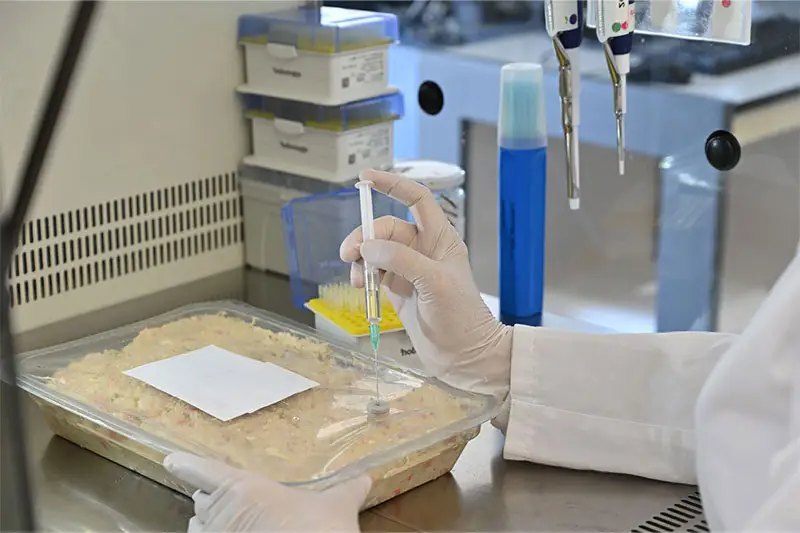Microbiological Testing of Essential Oils in Cosmetics
The microbiological safety testing of essential oils used in cosmetics is a critical process ensuring that products are safe and free from harmful microorganisms. Essential oils, derived from various plants, are widely incorporated into cosmetic formulations to provide fragrance, flavor, and therapeutic benefits. However, their natural origins also make them susceptible to microbial contamination which can compromise product quality and consumer safety.
Microbiological testing is essential for assessing the presence of pathogenic microorganisms such as Bacillus cereus, Listeria monocytogenes, and Pseudomonas aeruginosa. These organisms can cause severe health issues including foodborne illnesses, skin infections, and other adverse reactions. The testing process involves several steps to ensure accurate results:
- Sample Collection: Proper collection of samples is crucial for microbiological analysis. Samples should be collected aseptically using sterile swabs or pipettes.
- Preservation: Samples are preserved in appropriate media such as buffered peptone water (BPW) or tryptic soy broth to prevent growth during transport and storage.
- Incubation: Culturing samples on selective media allows for the isolation of specific microorganisms. For instance, Pseudomonas species can be identified using thiosulfate-citrate-bile salts-sucrose agar (TCBS).
- Identification: Identification is performed through biochemical tests and molecular techniques like polymerase chain reaction (PCR) for specific pathogenic strains.
- Quantification: Quantitative methods such as colony-forming unit (CFU)/mL determination provide an estimate of viable microbial numbers in the sample.
The importance of microbiological testing extends beyond ensuring safety; it also enhances product quality and consumer trust. By adhering to international standards like ISO 17244, laboratories ensure consistent and reliable test results. This standard provides guidelines for the enumeration of total viable counts (TVC) in cosmetic products containing essential oils.
Quality managers and compliance officers play a pivotal role in overseeing microbiological testing. They must ensure that all samples are handled according to best practices and that laboratory equipment is calibrated regularly. R&D engineers benefit from these tests as they can identify potential sources of contamination early in the product development cycle, allowing for timely corrective actions.
Microbiological testing also impacts the procurement process by helping companies source high-quality raw materials. By partnering with laboratories that adhere to strict standards, manufacturers can ensure consistent product quality across batches and suppliers.
Applied Standards
The microbiological safety testing of essential oils in cosmetics is governed by various international standards aimed at ensuring the safety and efficacy of cosmetic products. Key standards include:
- ISO 17244: Microbiological Examination of Cosmetics – Enumeration of Total Viable Counts: This standard outlines procedures for determining the total viable count in cosmetics containing essential oils.
- ASTM D3806-18: Standard Practice for the Preparation and Sterilization of Culture Media: Ensures that culture media used in microbiological testing are appropriate and sterile.
- EN 957: Cosmetics – Sampling Procedures: Provides guidelines on how to collect samples accurately from cosmetic products containing essential oils.
- IEC 62384-1: Medical Devices – Microbiological Safety of Medical Devices – Part 1: General Requirements: Although not directly related, this standard emphasizes the importance of microbiological safety in medical devices which can inform best practices in cosmetics testing.
Adherence to these standards ensures that laboratories provide consistent and reliable results. Compliance officers should be familiar with these guidelines to ensure that their laboratory adheres to them during testing.
Competitive Advantage and Market Impact
Conducting thorough microbiological testing of essential oils in cosmetics not only ensures safety but also offers several competitive advantages:
- Informed Decision-Making: Quality managers can use test results to make informed decisions regarding ingredient sourcing and formulation adjustments.
- Consumer Trust: Consumers are increasingly concerned about product safety. A proven track record of microbiological testing enhances brand reputation and customer trust.
- Regulatory Compliance: Adhering to international standards helps avoid penalties and sanctions from regulatory bodies, ensuring a smooth market presence.
- Product Differentiation: Brands that prioritize safety through rigorous testing can differentiate themselves in the crowded cosmetics market. This can lead to higher customer loyalty and satisfaction.
The impact of microbiological testing extends beyond individual brands; it contributes positively to the overall reputation of the cosmetic industry. By setting high standards for product safety, companies contribute to a safer and more trusted marketplace.
Use Cases and Application Examples
The application of microbiological testing in essential oils used in cosmetics is vast and varied:
- New Product Development: R&D engineers can use test results to identify potential contaminants early in the product development process. This allows for timely corrective actions, ensuring that new products meet safety standards.
- Sourcing Raw Materials: Procurement teams rely on microbiological testing reports to source high-quality raw materials from reliable suppliers. This ensures consistent quality across batches and minimizes risks of contamination.
- Batch Release Testing: Laboratories conduct microbiological tests on each batch of essential oils before release, ensuring that all products meet safety standards.
- Quality Assurance Audits: Quality managers use test results during internal audits to ensure compliance with international standards. This helps in maintaining a consistent quality level across batches and suppliers.
These applications underscore the importance of microbiological testing in ensuring product safety, enhancing market reputation, and driving regulatory compliance.





